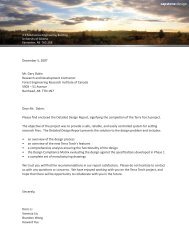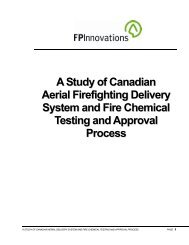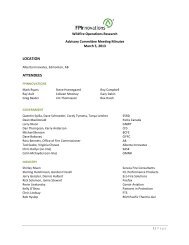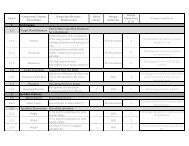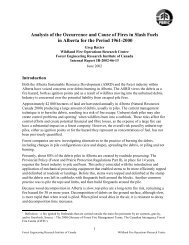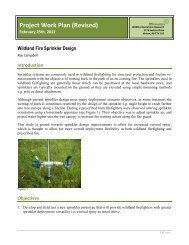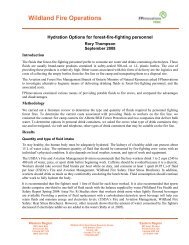Report: Chisholm wildfire entrapment investigation - FPInnovations ...
Report: Chisholm wildfire entrapment investigation - FPInnovations ...
Report: Chisholm wildfire entrapment investigation - FPInnovations ...
Create successful ePaper yourself
Turn your PDF publications into a flip-book with our unique Google optimized e-Paper software.
PROCEDURES<br />
Responsible Parties<br />
Notification<br />
Key<br />
Components<br />
It is the responsibility of operational and key administrative staff (such as<br />
dispatchers) to be aware of potential threats to personnel and air<br />
operations. It is the Fire Control Officer’s responsibility to ensure<br />
adequate Advisories and Warnings are issued. When personnel are<br />
dispatched to an area for which an Advisory or Warning has been issued,<br />
the dispatch information must include the Advisory or Warning. Incident<br />
Commanders or project leaders must confirm their understanding of the<br />
situation and provide the dispatch centre with feedback on actual<br />
conditions.<br />
When an Advisory or Warning is issued, ALL affected resources<br />
WITHIN and ADJOINING the AFFECTED AREA will be advised by the<br />
most expeditious means. Radio Operators transmitting Advisories or<br />
Warnings must receive acknowledgements from personnel intended to<br />
receive it. An applicable Advisory or Warning CANNOT BE IGNORED.<br />
Every Advisory and Warning must include:<br />
• type of Advisory or Warning;<br />
• date and time of issuance;<br />
• applicable geographic area (simple geographic description of the<br />
specific area affected);<br />
• expected arrival time and duration of disturbance;<br />
• description of conditions expected;<br />
• Who should receive it and how it is to be distributed (e.g., radio,<br />
telephone, or fax to all Zones, bases, active Fires, PATC, PFCO and<br />
neighbouring Fire Centres).<br />
Wind Advisory A Wind Advisory is issued to alert personnel that forecast conditions may<br />
present hazards to air operations, fireline or project operations.<br />
A Wind Advisory must include:<br />
• type and intensity of disturbance (e.g., outflow winds gusting to 50<br />
km/h).<br />
Fire Behaviour Advisory Issuing Offices must adopt a format that highlights the period during<br />
which forecast conditions are expected to exceed Intensity Class IV.<br />
A Fire Behaviour Advisory must include:<br />
• relevant fuel type(s).<br />
Extreme Fire Behaviour<br />
Warning<br />
Issuance<br />
An Extreme Fire Behaviour Warning must include:<br />
• intensity of disturbance (e.g., generating 70 km/h winds);<br />
• expected effect on fire behaviour (e.g., change in spread direction or<br />
fire intensity);<br />
• relevant fuel type(s);<br />
• if extreme fire behaviour is imminent, all personnel must be fully<br />
prepared to follow any specific instructions issued by the Incident<br />
Commander.<br />
Three levels of the organization can initiate an Advisory or Warning:<br />
Provincial Fire Centre (PFCO), Fire (IC) and Fire Centres (CFCO).<br />
Response Suppression strategies and tactics must be adjusted accordingly to ensure<br />
personnel safety is not jeopardized.<br />
Staff should report actual on-site weather conditions and fire behaviour<br />
characteristics to the Dispatch Centre to confirm or correct forecast<br />
information. Updates can then be passed on to others. The issuer should<br />
provide an explanatory note when forecast conditions do not occur.<br />
Advisories and Warnings must be retracted if forecast amendments<br />
mitigate the situation.<br />
Page 54 of 61



